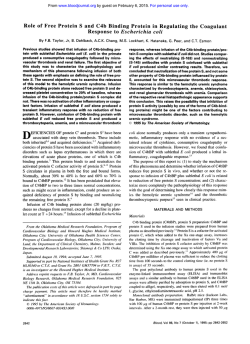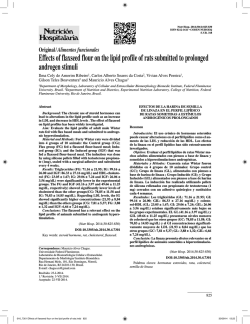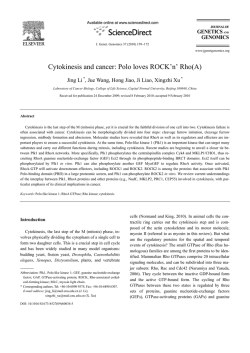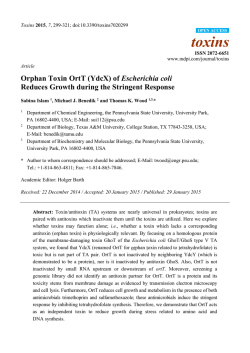
Growth Stasis by Accumulated L-aX-Glycerophosphate
JOURNAL OF BACTERIOLOGY, Nov., 1965 Copyright © 1965 American Society for Microbiology Vol. 90, No. 5 Printed in U.S.A. Growth Stasis by Accumulated L-aX-Glycerophosphate in Escherichia coli N. R. COZZARELLI, J. P. KOCH, S. HAYASHI,' AND E. C. C. LIN Department of Biological Chemistry, Harvard Medical School, Boston, Massachusetts Received for publication 27 July 1965 ABSTRACT In several instances, the mutational blocking of a catabolic pathway has rendered the affected organism sensitive to the compound whose dissimilation is thereby prevented. In the galactose pathway of Escherichia coli, for example, mutants which lack either the transferase, epimerase, or pyrophosphorylase not only fail to grow on galactose but also grow poorly, or not at all, on other carbon sources when galactose is present in the medium (Kurahashi and Wahba, 1958; Yarmolinsky et al., 1959; Sundararajan, Rapin, and Kalckar, 1962; see also Nikaido, 1961). Similarly a deficiency in the transferase in humans results in an intolerance to dietary galactose (Schwarz et al., 1956; Kalckar, 1960). Analogous effects have been observed with several other sugars. Thus, mutants of E. coli that lack either L-arabinose isomerase, L-ribulose kinase, or L-ribulose 5-phosphate 4-epimerase are sensitive to arabinose (Gross and Englesberg, 1959; Englesberg et al., 1 Present address: Laboratory of Molecular 1962; Isaacson and Englesberg, Bacteriol. Proc., p. 113, 1964). Partway metabolism may also account for the toxicity of rhamnose to wild-type Salmonella typhosa (Barkulis, 1949; Englesberg and Baron, 1959) and of mannose to honey bees (Sols, Cadenas, and Alvarado, 1960). A new example of growth stasis has been discovered in mutants of E. coli lacking a specific dehydrogenase which is essential for growth on glycerol and L-a-glycerophosphate (L-a-GP) as indicated in the following scheme (Koch, Hayashi, and Lin, 1964; Hayashi and Lin, 1965): MEDIUM Biology, National Institute of Arthritis and Metabolic Diseases, U.S. Public Health Service, Bethesda, Md. 1325 Glycerol CYTOPLASM Free diffusion _________________ Active transport L-a-GP system _ Glycerol Glycerol kinase La-GP I L-a-GP dehydrogenose Dihydroxyacetone phosphate SCHEME 1 Downloaded from http://jb.asm.org/ on February 6, 2015 by guest COZZARELLI, N. R. (Harvard Medical School, Boston, Mass.), J. P. KOCH, S. HAYASHI, AND E. C. C. LIN. Growth stasis by accumulated L-a-glycerophosphate in Escherichia coli. J. Bacteriol. 90:1325-1329.1965.-Cells of Escherichia coli K-12 can grow on either glycerol or L-a-glycerophosphate as the sole source of carbon and energy. The first step in the dissimilation of glycerol requires a kinase, and the initial process of utilization of L-a-glycerophosphate involves an active transport system. In either case, intracellular L-a-glycerophosphate is an intermediate whose further metabolism depends upon a dehydrogenase. When this enzyme is lost by mutation, the cells not only fail to grow on glycerol or L-a-glycerophosphate, but are subject to growth inhibition in the presence of either compound. Resistance to inhibition by glycerol can be achieved by the loss of glycerol kinase. Such cells are still susceptible to growth inhibition by L-a-glycerophosphate. Similarly, in dehydrogenase-deficient cells, immunity to exogenous L-a-glycerophosphate can be achieved by genetic blocking of the active transport system. Such cells are still sensitive to free glycerol in the growth medium. Reversal of inhibition by glycerol or L-a-glycerophosphate in cells lacking the dehydrogenase can also be brought about by the addition of glucose. Glucose achieves this effect without recourse to catabolite repression. Our results suggest that growth stasis associated with the over-accumulation of L-a-glycerophosphate is due to interference with other cellular processes by competition with physiological substrates rather than to depletion of cellular stores of adenosine triphosphate or inorganic phosphate. 1326 J. BACTEIZI0L. COZZARELLI ET AL. The growth inhibition associated with the loss of the dehydrogenase will be the subject of the present report. MATERIALS AND METHODS Bacteria. All strains used in these studies were TABLE 1. Phenotype of parental strains Strain 1 6 7 8 9 PA201 Gl-Lc-PL-a-GP trans- dehy- Mating type kGcerol kinase Hfr Hfr Hf r Hf r Hf r F- port genas Control + + + + + + + + Inducible Inducible Constitutive Constitutive Constitutive Inducible + + + + - + - + RESULTS When glycerol or DL-a-GP was added to a logarithmic culture of wild-type cells utilizing casein hydrolysate, the rate of growth was accelerated (Fig. 1A). [Previous studies have shown that the D isomer is not a substrate for the L-a-GP transport system, and, moreover, cannot be utilized by cells without alkaline phosphatase TABLE 2. Genealogy and phenotype of derivative strains L-a-GP Strain Female parent Male parent Glycerol kinase transport dehydrogenase L-a-GP Control 121 122 129 134 136 PA201 6 8 8 7 9 + + + + _ + + + + _ _ + Inducible Constitutive Constitutive Constitutive Constitutive 121 PA201 PA201 PA201 Downloaded from http://jb.asm.org/ on February 6, 2015 by guest obtained by mating previously described Hfr strains (Table 1 and Hayashi, Koch, and Lin, 1964) with a female strain, PA201, from the Pasteur Institute collection. The mating procedure was that described by Adelberg and Burns (1960). The lineage and the phenotype of each recombinant strain are summarized in Table 2. The genes of the glycerol system are not closely linked (Cozzarelli, Hayashi, and Lin, Federation Proc. 24:417, 1965), which made it practical to obtain multiply blocked recombinants by serial matings. To avoid any secondary effects that might result from the presence of inducers, only constitutive strains were employed for the study of growth stasis. Culture media. The media used for growth studies contained inorganic salts and tris(hydroxymethyl)aminomethane-HCl buffer at pH 7.5 as described by Garen and Levinthal (1960). Inorganic phosphate was present at 0.6 mm to repress the formation of alkaline phosphatase (Horiuchi, Horiuchi, and Mizuno, 1959; Torriani, 1960). In all growth experiments, casein hydrolysate was added at a level of 1% as a source of carbon and energy, and the concentrations of other carbon compounds are given with the description of individual experiments. Cell growth. Growth rates of cells were followed turbidimetrically in 300-ml Erlenmeyer flasks fitted with side arms. A stationary-phase culture was inoculated into 20 ml of fresh medium at an initial density of 10 Klett units (420-m,u filter). Incubation was carried out at 37 C on a rotary shaker operated at about 200 cycles per min. Assay of enzymes and L-a-GP transport. The levels of glycerol kinase and L-a-GP dehydrogeniase were assayed with cell-free extracts (Lin et al., 1962), and the activity of the L-a-GP transport system was assayed with cells suspended in the inorganic medium (Hayashi et al., 1964). The specific activities of the various constitutive strains given in Table 3 were obtained from cells grown on casein hydrolysate alone. Assay of L-a-GP in the growth medium. For the measurement of L-a-GP released into the medium, the cells were removed from the culture by a Millipore filter (0.65-M pore size); the filtrate was adjusted to pH 9.5 and assayed with muscle L-a-GP dehydrogenase (Bublitz and Kennedy, 1954). The cuvettes contained: 0.3 mmole of sodium carboniate buffer at pH 9.5, 0.3 mmole of hydrazine, 2 jAmoles of NAD, 0.3 mg of L-a-GP dehydrogenase, a sample of the culture filtrate, and water to a final volume of 1 ml. L-Ca-GP dehydrogenase was omitted from the blank. The constituents of the culture medium did not interfere with the determination since standard values were obtained from known amounts of L-a-GP dissolved in a culture medium. Immunochemistry. Specific antiserum was isolated from rabbits immunized against crystalline preparations of glycerol kinase from E. coli (Hayashi and Lin, in preparation). The Ouchterlony double-diffusion technique (Kabat and Mayer, 1961) was used to detect the presence of cross-reacting material in extracts of mutants incapable of forming enzymatically active glycerol kinase. Reagents. Disodium DL-a-GP was purchased from Sigma Chemical Co., St. Louis, Mo.; glycerol and glucose from Merck & Co., Inc., Rahway, N.J.; casein acid hydrolysate from Ntutritional Biochemicals Corp., Cleveland, Ohio; and crystalline L-a-GP dehydrogenase from C. F. Boehringer and Sons, Mannheim, Germany. \:OL. 90, 1965 TABLE 3. Activities of enzymes and transport of strains employed for the study of growth stasis Relative specific activity Strain Glycerol kinase 122 129 134 136 L-a-GP transport 1.0* 1.0 1.1 <0.01 Ani amounit of 2.2 L-a-GP dehydrogenase 0.1 1.2 0.6 1lOt jAmoles 0.03 0.03 1.Ot 0.04 Of L-a-GP formed X min-' (mg of protein)-'. t An amouist of 1.3 m,umoles of L-a-GP accumulated X min-' (mg of dry cells)-'. t An amount of 0.26 ,mole of L-a-GP dehydrogenated X mil-I' (mg of protein)-'. STRAIN 134 A STRAIN 129 B 80 160 LUJ Y 140 -A 120- Hoo00 zx 80 60a 40D 20 0 2 HOURS 3 4 0 2 3 4 HOURS FIG. 1. Growth responses of cells to the addition of glycerol or DL-a!-GP. At the time indicated by the arrow, three parallel cultures of cells growing on casein hydrolysate (0) received, respectively: glycerol to 5 X 1O-3M (X), DL-a-GP to 2.5 X 10-3M (AL), and water (0). (A) L-a-GP dehydrogenase-positive cells. (B) L-a-GP dehydrogenase-negative cells. (Hayashi et al., 1964; Lin et al., 1962). Therefore, D-a-GP can be considered biologically inactive for the purpose of the present study.] The opposite effect was found in mutant cells lacking L-a-GP dehydrogenase, whose growth was brought to virtual cessation by the addition to the medium of either glycerol or DL-a-GP (Fig. 1B). These effects of glycerol and L-a-GP are bacteriostatic rather than bactericidal, as indicated by the finding that viable counts, taken at various intervals after the treatment, paralleled the turbidimetric measurements of the cultures. Such stasis effects are not limited to cells growing on casein hydrolysate, since similar results were produced in cells p)roliferating on other carbon sources, e.g., suc- cinate, which, like casein hydrolysate, do not exert appreciable catabolite repression on the enzymes of the glycerol system. Nor is the stasis phenomenon limited to a unique mutant, since three additional L-a-GP dehydrogenase-negative mutants displayed the same phenomenon. These results indicate that a simple block in the dehydrogenation reaction makes the cells sensitive to glycerol and L-a-GP. Moreover, the inhibition by these two compounds probably works through a common mechanism associated with the overaccumulation of the phosphorylated intermediate. Excessive accumulation of L-a-GP by dehydrogenase-deficient cells exposed to glycerol was revealed by the excretion of the phosphorylated compound into the growth medium. Thus, 1 hr after the addition of 5 X 10-3 M glycerol to a culture of strain 129 containing 0.5 mg of cells per ml, the concentration of L-a-GP in the medium reached a level of 2.6 X 10-4 M. The intracellular concentration of L-a-GP in such cells was approximately 0.02 M (see Hayashi and Lin, 1965). When dehydrogenase-positive cells were used in an otherwise identical experiment, no L-a-GP was excreted into the medium. Since glycerol itself cannot be accumulated against a concentration gradient (Hayashi and Lin, 1965), its inhibitory effect is presumed to depend solely upon its conversion to L-a-GP. Escape from the inhibitory effect of glycerol, but not of L-a-GP, should therefore be made possible by the loss of glycerol kinase. Figure 2A shows that the growth of such a doubly blocked strain was no longer retarded by glycerol, although its sensitivity to L-a-GP remained essentially unchanged. That the glycerol kinase negativity of this strain was the result of no more than a simple mutation in the structural gene is indicated both by the map position of the lesion and by the ability of this mutant to produce a protein immuno140 STRAIN 136 A STRAIN 122 B > ,,, 120 F- .- .. ...S UALuJ D z 40 20 lIl 0 2 HOURS 3 4 2 3 HOURS FIG. 2. Resistance of L -a-GP dehydrogenase-negative cells to glycerol resulting from the loss of the kinase (A) and to L-a-GP resulting from the loss of the transport system (B). For an explanation of the symbols, see the legend to Fig. 1. Downloaded from http://jb.asm.org/ on February 6, 2015 by guest * 1327 GROWTH INHIBITION BY GLYCEROPHOSPHATE IN E. COLI 1328 COZZARELLI ET AL. c 300 - STRAIN 129 z 2 00 Z'80 >- A STRAIN 129 B C'p, ! 60 ' X 01 20 Hj HOURS HOURS FIG. 3 Antagonistic action of glucose to the toxic effect of glycerol. (A) Three parallel cultures of cells growing on casein hydrolysate (0) were treated in the following manner: at the first arrow, glucose was added to one culture at 1% (0) and glycerol to the other two at 2.5 X 1t03 M (X). At the second arrow, glucose was added at 1% to one of the glycerol-treated cultures (0). (B) At the time indicated by the arrow one of the two parallel cultures of cells growing on casein hydrolysate (0) received glucose (El) and the other received glucose plus glycerol (0). DIscussIoN Two kinds of mechanisms might be considered in connection with the toxicity resulting from the production of a phosphorylated compound without its subsequent metabolism. On the one hand, the deleterious effects may be associated with the process of dead-end phosphorylation by leading to the depletion of cellular stores of adenosine triphosphate or inorganic phosphate. But this kind of a mechanism cannot explain how L-a-GP supplied by a specific active transport system can cause stasis in a mutant lacking both glycerol kinase and L-a-GP dehydrogenase. In this situation, there is no trapping of orthophosphate. A critical depletion of high-energy phosphates merely as a result of fruitless transport is unlikely in view of the continued presence of casein amino acids sufficient to provide energy for rapid growth. Furthermore, the futile transport of several other compounds in E. coli has not led to growth inhibition. The accumulation of galactose by galactokinase-negative cells (Kurahashi and Wahba, 1958) and of lactose by f3-galactosidasenegative cells (Hofsten, 1961) serves to illustrate this point, as does the transport of nonmetabolizable thiogalactosides (Denes, 1961). On the other hand, the blocked intermediate itself might be toxic when present at high concentrations. It may, for example, interfere with an enzymatic reaction in another pathway by competing with the physiological substrate. This kind of a mechanism can apply to growth inhibition by nonphosphorylated as well as phosphorylated intermediates. The finding that phosphorylated compounds are more often deleterious than nonphosphorylated ones may only reflect the key role of the former in intermediary metabolism and the likelihood that many enzymes have affinity for a phosphate moiety. The ameliorative effect of glucose observed in mutants blocked in various pathways can also be explained on a similar basis. The rapid metabolism of glucose should cause the levels of numerous intermediates to rise, including perhaps the substrate whose metabolism had been competitively blocked by the toxic compound. ACKNOWLEDGMENTS This investigation was supported by grant GB-3527 from the National Science Foundation, by Public Health Service grant GM-11983, and by the American Cancer Society. N. R. Cozzarelli was supported by a predoctoral fellowship from the National Science Foundation, J. P. Koch by a postdoctoral fellowship from the U.S. Public Health Service, and E. C. C. Lin by a Research Downloaded from http://jb.asm.org/ on February 6, 2015 by guest chemically indistinguishable from the active enzyme. Similar considerations would lead to the prediction that the loss of the L-a-GP transport system by cells lacking the dehydrogenase should confer resistance to exogenous L-a-GP, but not to free glycerol. This expectation was confirmed by the results shown in Fig. 2B. The effect of glucose on the stasis phenomenon in the glycerol system was next explored, because previous studies on the sensitivity to galactose (Yarmolinsky et al., 1959; Sundararajan et al., 1962) and arabinose (Englesberg et al., 1962) had revealed that glucose was able to counteract the growth-inhibitory effect of these compounds. In Fig. 3A it may be seen that the addition of glucose rescued dehydrogenase-negative cells from growth inhibition by glycerol. This alleviation cannot be attributed to the catabolite repression of glycerol kinase, since it occurred before this enzyme could have been diluted significantly by further growth. Nor does the presence of glucose simply prevent the uptake of glycerol. If this were the case, no growth inhibition should result when glucose is added simultaneously with glycerol. Figure 3B shows that glycerol produced a transient arrest of growth even when given together with glucose. Experiments were also carried out with DL-a-GP, and essentially the same results were obtained. J. BACTERIOL.- VOL. 90, 1965 GROWTH INHIBITION BY GLYCEROPHOSPHATE IN E. COLI Career Development Award from the U.S. Public Health Service. 9:314-331. HAYASHI, S., J. P. KOCH, AND E. C. C. LIN. 1964. Active transport of L-a-glycerophosphate in Escherichia coli. J. Biol. Chem. 239:3098-3105. HAYASHI, S., AND E. C. C. LIN. 1965. Capture of glycerol by cells of Escherichia coli. Biochim. Biophys. Acta 94:479-487. HOFSTEN, B. v. 1961. The inhibitory effect of galactosides on the growth of Escherichia coli. Biochim. Biophys. Acta 48:164-171. HORIUCHI, T., S. HORIUCHI, AND D. MIZUNO. 1959. A possible negative feedback phenomenon controlling formation of alkaline phosphomonoesterase in Escherichia coli. Nature 183:1529-1530. KABAT, E. A., AND M. M. MAYER. 1961. Experimental immunochemistry. Charles C Thomas, Publisher, Springfield, Ill. KALCKAR, H. M. 1960. Biochemical genetics as illustrated by hereditary galactosemia. Ciba Found. Symp. Biochem. Human Genet., p. 23. KOCH, J. P., S. HAYASHI, AND E. C. C. LIN. 1964. The control of dissimilation of glycerol and L-a-glycerophosphate in Escherichia coli. J. Biol. Chem. 239:3106-3108. KURAHASHI, K., AND A. J. WAHBA. 1958. Initerference with growth of certain Escherichia coli mutants by galactose. Biochim. Biophys. Acta 30 :298-302. LIN, E. C. C., J. P. KOCH, T. M. CHUSED, AND S. E. JORGENSEN. 1962. Utilization of L-a-glycerophosphate by Escherichia coli without hydrolysis. Proc. Natl. Acad. Sci. U.S. 48:2145-2150. NIKAIDO, H. 1961. Galactose-sensitive mutants of Salmonella. I. Metabolism of galactose. Biochim. Biophys. Acta 48:460-469. SCHWARZ, V., L. GOLBERG, G. M. KOMROWER, AND A. HOLZEL. 1956. Some disturbances of erythrocyte metabolism in galactosaemia. Biochem. J. 62:34-40. SOLS, A., E. CADENAS, AND F. ALVARADO. 1960. Enzymatic basis of mannose toxicity in honey bees. Science 131:297-298. SUNDARARAJAN, T. A., A. M. C. RAPIN, AND H. M. KALCKAR. 1962. Biochemical observations on E. coli mutants defective in uridine diphosphoglucose. Proc. Natl. Acad. Sci. U.S. 48:21872193. TORRIANI, A. 1960. Influence of inorganic phosphate in the formation of phosphatases by Escherichia coli. Biochim. Biophys. Acta 38:460469. YARMOLINSKY, M. B., H. WIESMEYER, H. M. KALCKAR, AND E. JORDAN. 1959. Hereditary defects in galactose metabolism in Escherichia coli mutants. II. Galactose-induced sensitivitv. Proc. Natl. Acad. Sci. U.S. 45:1786-1791. Downloaded from http://jb.asm.org/ on February 6, 2015 by guest LITERATURE CITED ADELBERG, E. A., AND S. N. BURNS. 1960. Genetic variation in the sex factor of Escherichia coli. J. Bacteriol. 79:321-330. BARKULIS, I. L. 1949. Growth inhibition of Eberthella typhosa by certain carbohydrates and its release by mutation. J. Bacteriol. 58:103-109. BUBLITZ, C., AND E. P. KENNEDY. 1954. Synthesis of phosphatides in isolated mitochondria. III. The enzymatic phosphorylation of glycerol. J. Biol. Chem. 211:951-961. DANES, G. 1961. The effect of lactose and thiogalactosides on the multiplication of ,3-galactosidase constitutive mutants of Escherichia coli. Acta Physiol. Hung. 20:217-227. ENGLESBERG, E., R. L. ANDERSON, R. WEINBERG, N. LEE, P. HOFFEE, G. HUTTENHAUER, AND H. BOYER. 1962. L-Arabinose-sensitive, L-ribuloSe 5-phosphate 4-epimerase-deficient mutants of Escherichia coli. J. Bacteriol. 84:137-146. ENGLESBERG, E., AND L. S. BARON. 1959. Mutation to L-rhamnose resistance and transduction to L-rhamnose utilization in Salmonella typhosa. J. Bacteriol. 78:675-686. GAREN, A., AND C. LEVINTHAL. 1960. A fine-structure genetic and chemical study of the enzyme alkaline phosphatase of E. coli. I. Purification and characterization of alkaline phosphatase. Biochim. Biophys. Acta 38:470-483. GROSS, J., AND E. ENGLESBERG. 1959. Determination of the order of mutational sites governing L-arabinose utilization in Escherichia coli B/r by transduction with phage P 1 bt. Virology 1329
© Copyright 2026



